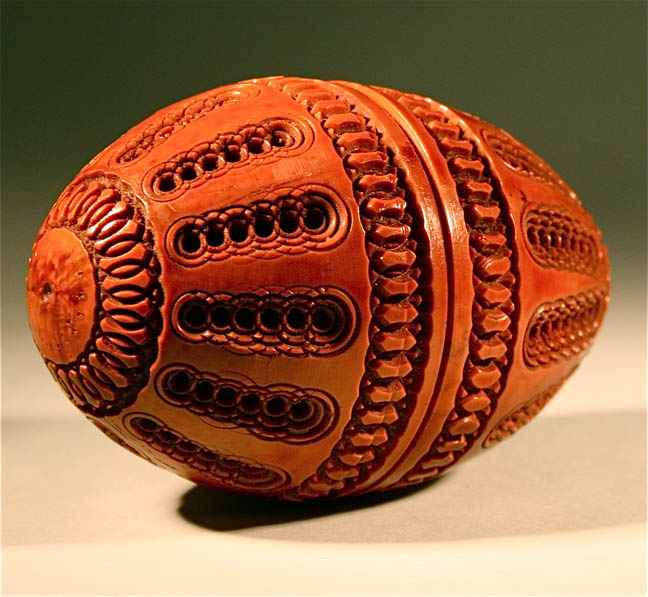

Title: Egg carved from a coquilla nut sewing box
Shipping: $9.00
Artist: N/A
Period: 19th Century
History: N/A
Origin: Central Europe > France
Condition: Excellent
Item Date: 1800 to 1920
Item ID: 2285
Antique nut wooden sewing egg nicely carved and turned. This sewing egg is in good condition, nicely design in hard nut wood. This unique wooden sewing egg-shaped holder circa 1900 screws shut. Egg Shaped hand carved nut sewing Holder or a Coquilla nut. This is from the regency looking period. It is all original and It has been turned with thread barrels that have been fitted. The subtle exterior belies the interior of the box which is in real exuberant Regency style, executed with impeccable attention to detail and quality. I was told this is possibly a Coquilla nut flea trap 18th or 19th century, one put a little blood with wax or honey and they attracted the fleas who then got stuck in the wax etc,ladies wore them around the necks as fleas were more attracted to women possibly because of the mental cycle they were also put into beds.
Link: http://en.wikipedia.org/wiki/Woodworking
Woodworking is the process of building, making or carving something using wood.
Along with stone, mud, and animal parts, wood was certainly one of the first materials worked by primitive human beings. Microwear analysis of the Mousterian stone tools used by the Neanderthals show that many were used to work wood. The development of civilization was closely tied to the development of increasingly greater degrees of skill in working these materials. Carved wooden vessels are known, for example, from the Linear Pottery culture wells at Kückhofen and Eythra. Examples of Bronze Age wood-carving include tree trunks worked into coffins from northern Germany and Denmarkand wooden folding-chairs. The site of Fellbach-Schmieden in Germany has provided fine examples of wooden animal statues from the Iron Age. Wooden idols from the La Tène period are known from a sanctuary at the source of the Seine in France. Two ancient civilizations that used woodworking were the Egyptians and the Chinese. Woodworking is depicted in many ancient Egyptian drawings, and a considerable amount of ancient Egyptian furniture (such as stools, chairs, tables, beds, chests) has been preserved in tombs. As well, the inner coffins found in the tombs were also made of wood. The metal used by the Egyptians for woodworking tools was originally copper and eventually, after 2000 BC bronze as ironworking was unknown until much later.[1] Commonly used woodworking tools included axes, adzes, chisels, pull saws, and bow drills. Mortise and tenon joints are attested from the earliest Predynastic period. These joints were strengthened using pegs, dowels and leather or cord lashings. Animal glue came to be used only in the New Kingdom period.[2] Ancient Egyptians invented the art of veneering and used varnishes for finishing, though the composition of these varnishes is unknown. Although different native acacias were used, as was the wood from the local sycamore and tamarisk trees, deforestation in the Nile valley resulted in the need for the importation of wood, notably cedar, but also Aleppo pine, boxwood and oak, starting from the Second Dynasty.